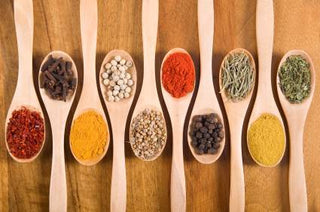Looking for a way to curb your salt habit? A great way is by doctoring up your meals with herbs & spices. Derived from the leaves, roots, bark, buds and fruit of various plants, herbs and spices add flavor and increase the nutritional content of foods. While it may take some time to “retrain” your taste buds, after some time you’ll lose the craving for salty foods. This is good news as these foods are often higher in calories and fat.
Cutting back our sodium intake is a key national health objective. Why? Most Americans consume way too much – on average 3,400 mg a day. Given that our bodies only need about 200 mg a day to perform daily functions and fluid maintenance, this imbalance leads to health problems. In fact, excess sodium intake is associated with elevated blood pressure which can harm the arteries and cause an increase in the risk of stroke, heart attack, kidney failure and blindness.
Unfortunately, reducing our dependence on salt is not easy. Sodium is pervasive in the food supply, especially in packaged/processed foods, fast food and restaurant fare. Vegetable juices, canned vegetables, deli meats, soups, spaghetti sauce and condiments are also loaded in sodium. But, sodium can be found in places that you wouldn’t normally expect like cereals, medications and even dairy.
To test your knowledge of sodium, take the American Heart Association’s online quiz. You may be surprised to learn a few things about this spice.
Health-Promoting Herbs & Spices
While adding herbs & spices to meals can help you kick the salt habit they can also make your foods more enjoyable. Perhaps more importantly, many herbs & spices have a number of unique health-promoting properties. So, adding them to meals boosts their nutritional content.
We’ve come up with a list of 12 herbs and spices that we encourage you to use while preparing foods. These twelve were selected based on their wide availability (e.g., basil, dill, oregano), high nutritional content (vitamin, minerals, phytochemicals) and health-promoting properties. But, we encourage you to experiment with others not included on the list (e.g., cinnamon).
While we give a brief description here, click on each to obtain more in-depth information on the health benefits, nutritional value, recipe ideas and interesting facts about each plant. Enjoy!
12 Herbs & Spices
The following is a list of the top 12 herbs and spices, along with their health promoting properties and ideas about how you can add to your next meal.
Basil – known as the “tomato herb” because basil accents tomato dishes so nicely. Compounds in basil have potent antioxidant, anti-cancer, antiviral and anti-microbial properties. This wonderful herb is a also a good source of vitamin K.
Cayenne Pepper - The hot and spicy flavor associated with cayenne pepper is capsaicin, an anti-inflammatory compound that when taken orally or applied topically helps with pain relief.
Curry – Not a single herb but a blend of spices, the primary ingredient in curry is turmeric. Curcumin is what gives turmeric its distinctive yellow color and is associated with the health benefits of curry including antioxidant and anti-inflammatory properties.
Dill - As a carminative (helps with intestinal gas), dill aids digestion, stimulates the appetite, and settles the stomach.
Garlic - Rich in a variety of sulfur-containing compounds including allicin and dithiins. While these compounds are responsible for garlic's characteristically pungent odor they are also the source of many of this herb’s cardiovascular health benefits.
Ginger – Traditionally used as a digestive aid to relieve symptoms from an upset stomach, motion sickness and morning sickness. The active constituents in ginger including gingerols not only give this spice its unique flavor but inhibit the formation of anti-inflammatory compounds.
Oregano – this herb is associated with Greek and Italian cooking. A USDA study found that, gram for gram oregano has the highest antioxidant activity of 27 fresh culinary herbs.
Paprika - The active compound in paprika, capsicum, is associated with anti-inflammatory properties. Paprika is an excellent source of vitamin A, primarily as beta carotene, but also as lutein, zeaxanthin and beta cryptoxanthin.
Parsley - Fresh parsley is an excellent source of vitamin K, a good source of vitamin C and the carotenoids lutein and zeaxanthin.
Rosemary - Contains substances that are useful for stimulating the immune system, increasing circulation, and improving digestion. Rosemary also contains anti-inflammatory compounds.
Sage - Compounds in sage have numerous brain health benefits including memory enhancement and inhibiting an enzyme that is associated with Alzheimer’s disease.
Thyme - Contains an essential oil that is rich in thymol, a powerful antiseptic, antibacterial, and a strong antioxidant. Thyme also contains flavonoids including apigenin, naringenin, luteolin, and thymonin that have potent antioxidant activity.

